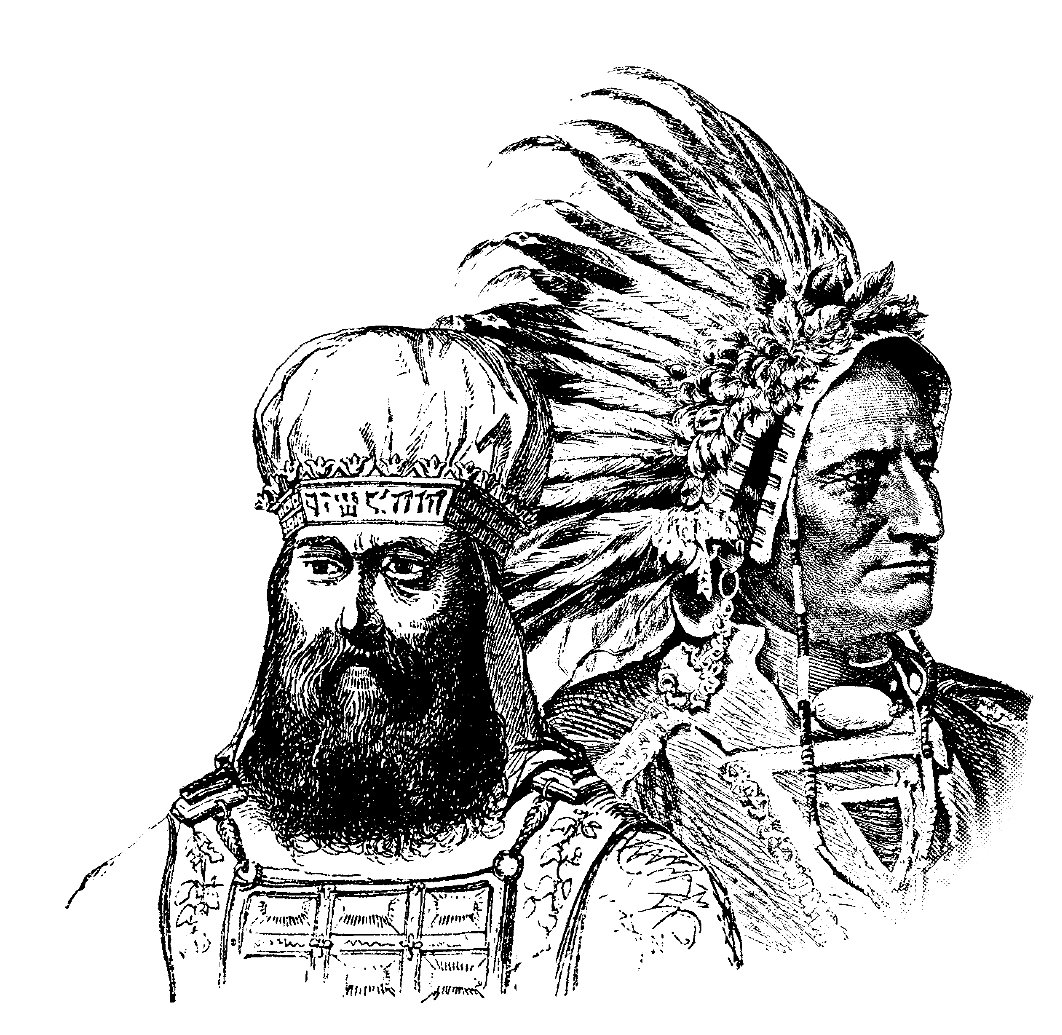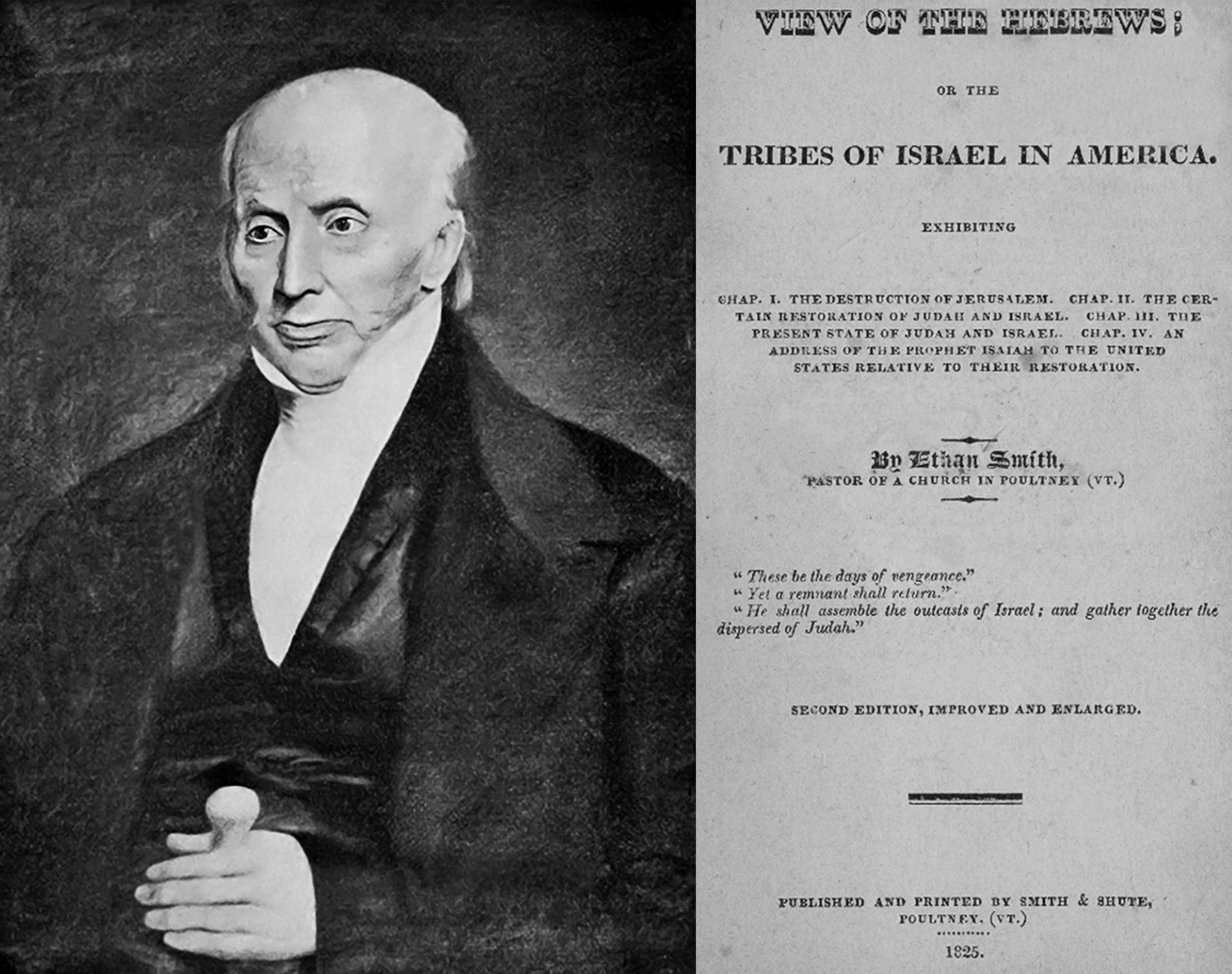The Book of Mormon and View of the Hebrews

In 1823, a Congregationalist minister named Ethan Smith published a book called View of the Hebrews (a second edition appeared in 1825). In his book, Smith argued that the Native Americans were descendants of the Lost Tribes of Israel. Some have claimed that View of the Hebrews influenced Joseph Smith and the Book of Mormon, and that Oliver Cowdery may have played a key role as the one who passed on the book or its ideas to Joseph. This Q&A reviews the history of View of the Hebrews controversy.
Timeline of the Book of Mormon and View of the Hebrews
The Early Lives of Ethan Smith, Joseph Smith, and Oliver Cowdery; the Publication of View of the Hebrews; the Coming Forth of the Book of Mormon.
1780
Ethan Smith fights in the Revolutionary War.[2]
1785-1790
Ethan Smith studies at Dartmouth.[3]
January 25, 1792
Ethan Smith becomes the first pastor of the Congregational Church in Haverhill, Grafton County, New Hampshire.[4]
March 12, 1800
Ethan Smith is installed as a pastor in Hopkinton, Merrimack County, New Hampshire.[5]
Circa 1809
The Cowdery family moves to Poultney, Rutland County, Vermont.[9]
March 18, 1810
Summer 1810
The Cowdery family moves to Williamson, Ontario County, New York.[11]
1811
The Joseph Smith Sr. family moves to Lebanon, Grafton County, New Hampshire.[12]
May 26, 1811
Oliver's stepmother Keziah receives a "letter of recommendation" from the Congregational Church in Poultney.[13]
Circa 1813–1814
The Cowdery family returns to Middletown, Rutland County, Vermont.[14]
1816
The Smith family moves to Palmyra, Wayne County, New York.[15]
1818
The Smith family moves to Manchester Township, Ontario County, New York.[16]
February 26, 1818
Ethan Smith is installed as a pastor of a Presbyterian church in Hebron, Washington County, New York.[17]
August 2, 1818
1820
The Cowdery family is recorded in the 1820 census as living in Poultney, Rutland County, Vermont.[19]
November 21, 1821
Ethan Smith becomes pastor of the Congregational Church in Poultney.[20]
1821–1822
Oliver Cowdery attends school in Wells, Rutland County, Vermont.[21]
November 1822
June 11, 1823
Ethan Smith secures a copyright for the View of the Hebrews.[23]
July 1823
The Poultney Gazette indicates View of the Hebrews is at press.[24]
September 21, 1823
The angel Moroni appears to Joseph Smith and informs him of the gold plates.[25]
December 1823
April 1825
Ethan Smith publishes a second edition of View of the Hebrews.[32]
1825
December 29, 1826
Ethan Smith is dismissed from his pastorate in Poultney because a "misunderstanding had arisen between one of the deacons and himself."[36]
May 16, 1827
Ethan Smith becomes pastor of a Congregational Church in Hanover, Plymouth County, Massachusetts, his last pastoral charge before becoming a domestic missionary in Boston beginning in 1832.[39]
September 21, 1827
Joseph Smith receives the gold plates and begins the translation of the Book of Mormon.[40]
December 1827
Joseph Smith moves to Harmony Township, Susquehanna County, Pennsylvania.[41]
Summer 1828
Joseph translates at least 116 manuscript pages of the Book of Mormon.[42]
April 5, 1829
Oliver Cowdery meets Joseph for the first time in Harmony.[43]
The Public Reception of View of the Hebrews and the Book of Mormon; Ethan Smith's Writings Post-1830; the Early Latter-day Saint Response to View of the Hebrews.
1830–1844
Various writers react to the arguments made in View of the Hebrews about the origins of Native Americans.[45]
1831
1832
1834
1841
June 1842
Joseph Smith, as editor of the Times and Seasons, republishes extracts from View of the Hebrews to support the idea that migrations occurred from the Old World to the New World.[50]
1842
June 27, 1844
Joseph Smith dies in Carthage, Hancock County, Illinois.[52]
August 29, 1849
Ethan Smith dies in Boylston, Worcester County, Massachusetts.[53]
March 3, 1850
Oliver Cowdery dies in Richmond, Ray County, Missouri.[54]
1859
25 years pass
First Documented Accusations of the Book of Mormon's Dependence on View of the Hebrews; Modern Latter-day Saint Response to View of the Hebrews.
1884
April 1887
An anonymous newspaper report in the Cleveland Plain Dealer suggests some kind of possible connection between the Hebrew-Indian origins theory of Ethan Smith and the Book of Mormon.[58]
February 1896
The Contributor, published by the Church, positively cites View of the Hebrews as evidence that supports the Book of Mormon.[59]
January 1902
The claim that the Book of Mormon directly plagiarized View of the Hebrews is documented for the first time in a debate between a member of the RLDS Church and the Campbellite Church over the origins of the Book of Mormon.[60]
1902
October 1902
1903
The Church publishes a manual on the Book of Mormon for young adults that includes citations of View of the Hebrews to support the idea of Native Americans originating from the Old World.[63]
1909
1909
Clark Braden again argues that Mormon writers plagiarized ideas in View of the Hebrews.[65]
1912
Late-1921 to early-1922
B. H. Roberts conducts unpublished research on whether View of the Hebrews could have influenced Joseph Smith and the Book of Mormon.[68]
1930s
1930s
Rumors about the existence of Roberts's manuscript comparing the Book of Mormon and View of the Hebrews begin circulating.[70]
1937
A Church publication on the Book of Mormon for young adult Latter-day Saints cites Ethan Smith to support the idea that Native Americans are of "Hebrew origin."[71]
Modern Theories and Debates about View of the Hebrews and the Book of Mormon.
1945
1946
B. H. Roberts's unpublished research on the parallels between View of the Hebrews and the Book of Mormon begins privately circulating.[74]
1948
The Church's Spanish-language periodical Liahona cites View of the Hebrews as evidence supporting the Book of Mormon.[75]
1961
1945–1976
September 1976
An article in the Ensign directly addresses the theory that the Book of Mormon was derived from View of the Hebrews.[79]
1980s
October 1993
1996
Brigham Young University republishes View of the Hebrews.[85]
October 2009
November 2016
2018
The Church releases a "Church History Topic" essay that briefly addresses the controversy surrounding View of the Hebrews.[88]
What is View of the Hebrews?
View of the Hebrews is an 1823 book[89] by Ethan Smith[BIO] that argues that the Native Americans were descendants of the lost Ten Tribes of Israel.[90] Ethan Smith cited biblical passages, Jewish history, and Indian customs and legends to support his arguments.[91]
Ethan Smith was a reverend from New England who pastored several churches in New Hampshire, New York, Massachusetts, and Vermont.[92]
What does View of the Hebrews have to do with the Book of Mormon?
At the beginning of the twentieth century, people began pointing out parallels between the Book of Mormon and View of the Hebrews.[93]
Some have argued that Joseph Smith must have plagiarized ideas from View of the Hebrews to produce the Book of Mormon.[94][95] Others have used it as supporting evidence for parts of the Book of Mormon.[96]
What kind of parallels does this mean?
There are several commonly cited parallels between View of the Hebrews and the Book of Mormon (see table below).
Examples of Parallels Between View of the Hebrews and the Book of Mormon
View of the Hebrews (1823/1825) | Book of Mormon (1830) |
Published in Poultney, Rutland County, Vermont | Joseph Smith was born in Sharon, Windsor County, Vermont |
Hebrew origin for Native Americans | Hebrew origin for Native Americans |
The destruction of Jerusalem | The destruction of Jerusalem |
A hidden Indian parchment and lost Indian records | Gold plates hidden in the Hill Cumorah |
Inspired prophets among the Native Americans | Inspired prophets among the Nephites (Native Americans) |
Indian shamans possess an object similar to the Israelite high priest's Urim and Thummim | Joseph Smith described using the Urim and Thummim to translate the Book of Mormon. |
Barbarous and civilized tribes of Native Americans | Barbarous (Lamanites) and civilized (Nephites) peoples described in the Book of Mormon |
Citations of the prophet Isaiah | Citations of the prophet Isaiah |
A great Gentile nation | A great Gentile nation |
Polygamy, riches, and pride denounced | Polygamy, riches, and pride denounced |
Prophecies about the "stick of Joseph" and the "stick of Judah" | Prophecies about the "stick of Joseph" and the "stick of Judah" |
Quetzalcoatl as a type of Christ | Christ's appearance to the Nephites in the New World |
Indians expected to be restored | Remnant of Lehi's seed (Indians) expected to be restored |
A great nation became extinct | A great nation became extinct |
America a choice land | America a choice land |
Idolatry and human sacrifice | Idolatry and human sacrifice |
Extensive wars and military fortifications | Extensive wars and military fortifications |
The name "Ethan Smith" | The name "Ether" |
Collated from B. H. Roberts's "A Parallel" (1927);[97] Fawn Brodie, No Man Knows My History (1945);[98] G. T. Harrison, Mormonism Now and Then (1961);[99] Jeremy Runnells, CES Letter (2013; 2017).[100] | |
What about the Isaiah chapters? Aren't those in View of the Hebrews too?
Yes. About one-third of the Isaiah chapters included in View of the Hebrews are also found in the Book of Mormon.[101]
Related Question
Is there scholarly consensus on who wrote Isaiah?
Read more in Deutero-Isaiah
Could Joseph have accessed a copy of View of the Hebrews before translating the Book of Mormon?
Yes. The book was widely distributed,[102] so it is possible that at some point Joseph could have read it or had its ideas shared with him.
Is there any evidence that Joseph ever read or knew about View of the Hebrews?
No, not in the 1820s during the translation of the Book of Mormon.[103] However, in 1842, Joseph Smith published an article in the Times and Seasons that referenced View of the Hebrews as supporting evidence for the Book of Mormon.[104]
Didn't Joseph Smith's family live close to Ethan Smith? Could he have met him?
Not really. The closest Joseph Smith lived to Ethan Smith was about 66 miles while Joseph was very young.[105] After that, the closest they lived together was over 200 miles apart.[106]
What about Oliver Cowdery? Is it true that Ethan Smith was Oliver Cowdery's pastor when he was a boy?
Possibly. Oliver Cowdery's[BIO] stepmother and three of his half-sisters were members of the same church in Poultney, Vermont, where Ethan Smith eventually became the pastor.[107] However, there is no record of Cowdery ever attending Ethan Smith's congregation as a boy.[108]
Didn't Oliver Cowdery work in the same printshop where Ethan Smith published View of the Hebrews?
No, probably not. Some have speculated that Cowdery may have worked in the same printshop that Ethan Smith used in the 1820s,[109] but there is no historical evidence to support this idea.[110] According to his half-sister, Cowdery worked as a store clerk in the mid-1820s, not a printer.[111]
But could Oliver Cowdery have somehow obtained a copy of View of the Hebrews and secretly given Joseph Smith a copy of the book?
Possibly, but probably not. While some have speculated this,[112] Cowdery first met Joseph Smith on April 5, 1829, almost a year and a half into the translation of the Book of Mormon.[113][114] By this time, Joseph had already translated extensive portions of the record.[115]
But with so many apparent parallels, doesn't this make it seem likely that Joseph took ideas from View of the Hebrews for the Book of Mormon?
Possibly, but probably not. Some of the parallels aren't actual parallels,[116] some are only superficial,[117] and others appear in the Bible.[118] This may be an example of "parallelomania," or the tendency to see excessive and unwarranted parallels or similarities in two things.[119]
Examples of False Parallels
Primary Source | Parallel Source | Comments |
The Wreck of the Titan: Or, Futility (1898) | Sinking of the Titanic (1912) | Morgan Robertson's novel The Wreck of the Titan: Or, Futility, originally published in 1898 has many uncanny similarities between it and the sinking of HMS Titanic in 1912, even though the two things were unrelated.[120] |
Abraham Lincoln Assassination (1864) | John F. Kennedy Assassination (1964) | There are a number of striking parallels in the lives and assassinations of Abraham Lincoln and John F. Kennedy.[121] However, there are also many false parallels between them.[122][123] |
Leaves of Grass (1855) | The Book of Mormon (1830) | Latter-day Saint writer Jeff Lindsay, in a satirical essay, has argued that Joseph Smith plagiarized the collection of poems Leaves of Grass by Walt Whitman because of the many "parallels" between the poems and the Book of Mormon.[124] |
Jesus Christ | Quetzalcoatl | Some have seen parallels between the depiction of Jesus Christ in the Bible and the Book of Mormon and the Aztec deity Quetzalcoatl.[125] However, these apparent parallels may be the result of Spanish missionaries and chroniclers consciously trying to make these two figures seem more similar than they actually are.[126] |
Was the central argument—that Native Americans were related to the tribes of Israel—in View of the Hebrews unique?
No. Several writers in the late eighteenth and early nineteenth centuries thought Native Americans were descendants of the Lost Tribes of Israel (see the table below).
Examples of Eighteenth- and Nineteenth-Century Books Promoting the Hebraic Indian Theory
Book |
James Adair, The History of the American Indians (1775)[127] |
Elias Boudinot, A Star in the West (1816)[128] |
Josiah Priest, The Wonders of Nature and Providence (1825)[129] |
Israel Worsley, A View of the American Indians (1828)[130] |
Barbara Anne Simon, The Hope of Israel (1829)[131] |
Solomon Bennett, A Theological and Critical Treatise of the Primogeniture and Integrity of the Holy Language (1835)[132] |
Mordecai M. Noah, Discourse on the Evidences of the American Indians Being the Descendants of the Lost Tribes of Israel (1837)[133] |
Could Joseph have gotten his ideas in the Book of Mormon from these other books?
Possibly, but probably not. There is no evidence that Joseph was influenced by or aware of these books during his translation.[134]
There was a copy of Josiah Priest's book in the town library where the Smiths lived,[135] but there is no evidence that Joseph, his family, or other early Church members were library patrons.[136][137]
Did Ethan Smith comment on the similarities between his book and the Book of Mormon?
No. Ethan did criticize the prominent contemporary Christian figure William Miller,[138] but there is no record of Ethan criticizing Joseph or accusing him of stealing his theory.

What do Latter-day Saints say about any connection between View of the Hebrews and the Book of Mormon?
Early on, Joseph Smith and other Latter-day Saints cited material from View of the Hebrews positively as evidence for the Book of Mormon.[139][140] More recently, Church leaders and scholars have argued against claims that Joseph must have plagiarized View of the Hebrews.[141][142]
Some Latter-day Saint scholars have noted there is no evidence that Joseph knew about View of the Hebrews while translating.[143] Others note significant differences or contradictions between the two.[144]
Examples of Arguments Against the Connection Between View of the Hebrews and Book of Mormon
Argument |
There is no evidence that Joseph was aware of View of the Hebrews during the translation of the Book of Mormon (1827–1830).[145] |
The commonly cited parallels between the two books are weak or unconvincing.[146] |
There are many significant differences or "unparallels" in style and detail.[147] |
Joseph republished extracts of View of the Hebrews in the Times and Seasons, which is not something a plagiarist would likely do.[148] |
Joseph omitted crucial arguments or claims from View of the Hebrews in the Book of Mormon and, at times, contradicted it.[149] |
The overall purpose, intent, and structure of the books are too different to suggest direct dependence.[150] |
What do non-Latter-day Saints scholars generally think about the relationship between View of the Hebrews and the Book of Mormon?
Some believe Joseph drew directly from material in the book or indirectly by some mode of cultural transmission.[151] Others think both books are separate examples of the "Hebraic Indian Theory"[152] popular in the early 1800s.[153]
Has the Church ever tried to hide the existence of View of the Hebrews?
No. Many Church publications have discussed View of the Hebrews, including the Improvement Era,[154] BYU Studies,[155] the Ensign,[156] and the Encyclopedia of Mormonism.[157] General Authorities have mentioned View of the Hebrews or Ethan Smith in general conferences, books, and other talks.[158]
In 1996, Brigham Young University published the original text of View of the Hebrews,[159] and both the Church History Library and Brigham Young University own original copies.[160]
Did B. H. Roberts lose his testimony because of the parallels between View of the Hebrews and the Book of Mormon?
No. In the early 1920s, B. H. Roberts conducted an unpublished study on potential parallels between View of the Hebrews and the Book of Mormon.[161] However, even after he conducted this study, Roberts continued affirming his belief in Joseph Smith and the Book of Mormon.[162]
Related Question
Did B. H. Roberts lose his testimony because of the View of the Hebrews?
Read more in B. H. Roberts's Testimony
- Luke
“I decided to read View of the Hebrews to see the fuss and quit at page 10. It sounded nothing like and referenced nothing in the Book of Mormon. It’s weak sauce.” - Jordan
“The smartest and most well-read opponents of the church are pretty consistent in knowing better than to promulgate the idea that the Book of Mormon was plagiarized from View of the Hebrews. That notion is most often expressed by people who haven’t read either book.”



 about this topic
about this topic